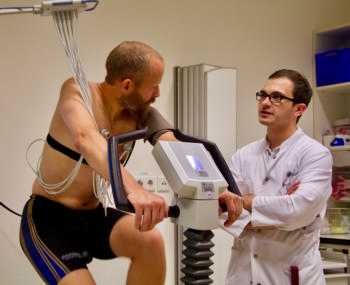Male Triathletes May Be Putting Their Heart Health at Risk
Released: November 21, 2017
At A Glance
- Male triathletes who log too much distance may be at risk for myocardial fibrosis of the left ventricle.
- Myocardial fibrosis, or scarring of the heart, might lead to heart failure.
- Evidence of myocardial fibrosis was seen in 18 percent of male triathletes studied, but none of the female triathletes.
- RSNA Media Relations
1-630-590-7762
media@rsna.org - Maureen Morley
1-630-590-7754
mmorley@rsna.org - Linda Brooks
1-630-590-7738
lbrooks@rsna.org
CHICAGO – Competitive male triathletes face a higher risk of a potentially harmful heart condition called myocardial fibrosis, according to research being presented next week at the annual meeting of the Radiological Society of North America (RSNA). The increased risk, which was not evident in female triathletes, was directly associated with the athletes’ amount of exercise.
Myocardial fibrosis is scarring of the heart. It usually affects the pumping chambers, also known as the ventricles. The condition might progress to heart failure. While regular exercise has beneficial effects on the cardiovascular system, previous studies have shown the presence of myocardial fibrosis in elite athletes.
“The clinical relevance of these scars is currently unclear,” said study lead author Jitka Starekova, M.D., fellow in the Department for Diagnostic and Interventional Radiology and Nuclear Medicine at University Medical Center Hamburg-Eppendorf in Hamburg, Germany. “However, they might be a foundation for future heart failure and arrhythmia.”
Dr. Starekova and colleagues recently studied a group of triathletes, including 55 men, average age 44, and 30 women, average age 43. The study group underwent cardiac MRI exams with the contrast agent gadolinium, which is taken up by both normal and injured heart muscle tissue. Gadolinium washes out quickly in normal heart tissue, but much more slowly in scarred tissue, revealing a difference in contrast between normal and injured heart muscle after approximately 10 minutes. This phenomenon, known as late gadolinium enhancement, is a useful tool for detection of myocardial fibrosis.
Evidence of myocardial fibrosis was apparent in the left ventricle — the heart’s main pumping chamber — in 10 of 55 of the men, or 18 percent, but in none of the women.
These same athletes had completed significantly longer total, swimming and cycling distances and had higher peak exercise systolic blood pressure than their counterparts without myocardial fibrosis.
Lifetime competition history for the athletes showed that the number of completed Iron Man triathlons and the number of middle distance triathlons were significantly higher in the male triathlete population compared to the female triathlete population, suggesting that the fibrosis risk was likely associated with exercise level.
“Comparison of the exercise test results revealed that female triathletes had lower systolic blood pressure at peak exercise and achieved lower maximal power compared to male triathletes,” Dr. Starekova noted. “Furthermore, comparison of the sport history showed that females had a tendency to complete shorter distances compared to male triathletes. This supports the concept that blood pressure and race distances could have an impact on formation of myocardial fibrosis.”
There are several possible factors for the link between the amount of exercise and the risk of myocardial fibrosis, according to Dr. Starekova. Higher exercise-induced systolic blood pressure may result in greater myocardial mass, she said, and more exercise might expose the athlete to a higher risk of myocarditis, or inflammation of the heart muscle. These factors, in combination with repeatedly increased stress of the left ventricular wall due to exercise, could injure the heart muscle.
Other factors may be responsible for the striking difference in myocardial fibrosis risk between male and female triathletes, Dr. Starekova said, including the presence of testosterone.
“Although we cannot prove the exact mechanism for the development of myocardial fibrosis in triathletes, increased systolic blood pressure during exercise, the amount and extent of race distances and unnoticed myocarditis could be cofactors in the genesis of the condition,” she said. “In other words, repetition of any extreme athletic activity may not be beneficial for everyone.”
The researchers plan long-term follow-up studies to see if any cardiac events occur in the triathletes who had evidence of myocardial fibrosis.
Co-authors are Enver Tahir, M.D., Kai Muellerleile, M.D., Alexandra von Stritzky, M.D., Julia Muench, M.D., Maxim Avanesov, M.D., Julius Weinrich, M.D., Christian Stehning, Sebastian Bohnen, M.D., Ulf K. Radunski, M.D., Eric Freiwald, M.D., Stefan Blankenberg, M.D., Gerhard Adam, M.D., Axel Pressler, M.D., Monica Patten, M.D., and Gunnar K. Lund, M.D.
Note: Copies of RSNA 2017 news releases and electronic images will be available online at RSNA.org/press17 beginning Monday, Nov. 27.
RSNA is an association of over 54,000 radiologists, radiation oncologists, medical physicists and related scientists, promoting excellence in patient care and health care delivery through education, research and technologic innovation. The Society is based in Oak Brook, Ill. (RSNA.org)
Editor’s note: The data in these releases may differ from those in the published abstract and those actually presented at the meeting, as researchers continue to update their data right up until the meeting. To ensure you are using the most up-to-date information, please call the RSNA Newsroom at 1-312-791-6610.
For patient-friendly information on cardiac MRI, visit RadiologyInfo.org.
Video clips (.mp4 format)

Video 2. Dr. Jitka Starekova discusses her research on the dangers of myocardial fibrosis in male triathletes
Download.mp4
(Right-click and Save As)

Video 3. Dr. Jitka Starekova discusses the most important finding of her research.
Download.mp4
(Right-click and Save As)

Video 4. Dr. Jitka Starekova discusses the most surprising finding of her research.
Download.mp4
(Right-click and Save As)

Video 5. Dr. Jitka Starekova discusses the dangers of myocardial fibrosis.
Download.mp4
(Right-click and Save As)

Video 6. Dr. Jitka Starekova discusses whether or not there is a maximum amount of activity that can be negative.
Download.mp4
(Right-click and Save As)

Video 7. Dr. Jitka Starekova discusses the differences seen between male and female athletes.
Download.mp4
(Right-click and Save As)
Images (.JPG and .TIF format)
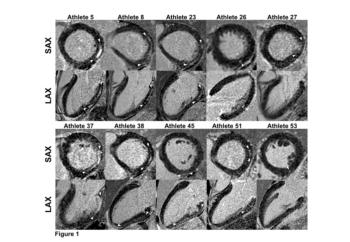
Figure 1. Short-axis and long-axis LGE images depicting a non-ischemic fibrosis pattern in all 10 LGE+ triathletes. LGE size, indicated by arrows, varied from small, point-shaped (triathlete 53) to larger and more distinct (triathletes 5, 8 and 37) areas of fibrosis.
High-res (TIF) version
(Right-click and Save As)
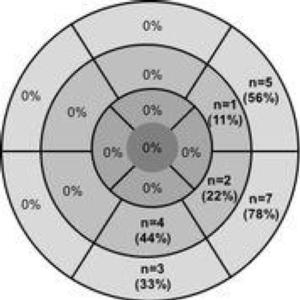
Figure 2. Schematic representation of myocardial fibrosis on CMR in LGE+ triathletes, which was predominantly localized in the basal inferolateral segment of the left ventricle.
High-res (TIF) version
(Right-click and Save As)
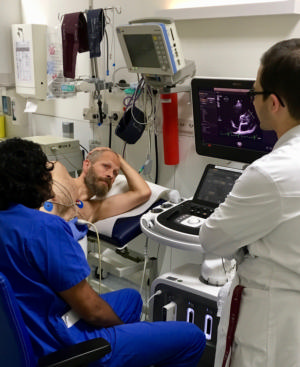
Figure 3. Triathlete undergoing echocardiographic examination.
High-res (TIF) version
(Right-click and Save As)
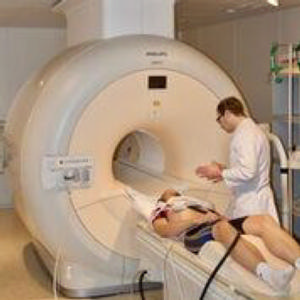
Figure 4. Triathlete receiving instruction prior to MRI scan.
High-res (TIF) version
(Right-click and Save As)


